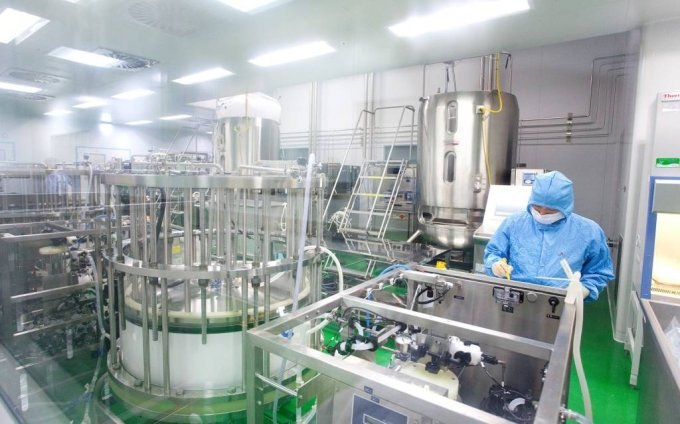Demand for flu vaccine expected to soar this year
With wider free immunization, vaccine makers ponder how to expand production
By Lim Jeong-yeoPublished : Aug. 13, 2020 - 15:07

Demand for flu vaccines is anticipated to more than double this year on the back of COVID-19 pandemic, according to industry sources.
As symptoms of influenza infection closely resemble that of the COVID-19 pandemic -- high fever and respiratory system inflammation -- by common sense the world anticipates there will be more demand for precautions against flu.
“If in the past some 20 million people took flu repelling shots here in South Korea, this year we expect the number to go up to 35 million to 40 million,” a vaccine company official told The Korea Herald.
It remains to be seen how each vaccine supplier in Korea approaches the production volume.
Leading homegrown vaccine makers SK Bioscience and GC Pharma told The Korea Herald that they have scaled up the output of their flu vaccines, although they refrained from sharing details.
As seasonal flu vaccines are generally administered between September and December, while vaccine production require four to six months depending on cell-derived or egg-derived method, manufacturing in theory is expected to be in full swing by mid-August.
The companies are cautiously advancing their production, however, as uncertainties persist on expanded output and actual profitability.
Other relevant players in the industry are Ilyang Pharmaceutical, Boryung Pharmaceutical, Dong-A ST, LG Chem, Korea Vaccine and foreign pharmas GSK and Sanofi.
Meanwhile, the government is also anticipating and preparing for a rise in flu vaccine demands in the upcoming months.
The Korea Centers for Disease Control and Prevention in early July conducted a telephone survey of those aged between 19 and 60, who are not covered by the National Immunization Program.
The survey revealed that some 50 percent of the respondents were willing to spend their own money on flu vaccine. Earlier, only 25 percent had shown such willingness.
NIP preemptively expanded in July the beneficiaries of state-funded free vaccination from the previous under-12s to under-18s, and over-65s to over-62.
NIP will cover the full cost of the flu vaccines for those in the designated “vulnerable age.” As for the rest who are aged between 19 and 61, they will bear their cost.
“With medical professionals and hospital beds occupied with COVID-19 patients, we cannot have cohorts of flu patients creating confusion. In order to save our medical resources from added stress and burden, we have expanded the scope of NIP flu vaccination,” said Choi Yeon-hwa, a researcher at the KCDC.
“Of course, influenza vaccine is not COVID-19 vaccine. Vigilance against the pandemic must continue even after taking the flu shots,” Choi said.
Vaccination for toddlers under the age of 9 will begin on Sept. 8; juveniles under 18 and pregnant women on Sept. 22; and seniors above 62 on Oct. 13.
By Lim Jeong-yeo (kaylalim@heraldcorp.com)
As symptoms of influenza infection closely resemble that of the COVID-19 pandemic -- high fever and respiratory system inflammation -- by common sense the world anticipates there will be more demand for precautions against flu.
“If in the past some 20 million people took flu repelling shots here in South Korea, this year we expect the number to go up to 35 million to 40 million,” a vaccine company official told The Korea Herald.
It remains to be seen how each vaccine supplier in Korea approaches the production volume.
Leading homegrown vaccine makers SK Bioscience and GC Pharma told The Korea Herald that they have scaled up the output of their flu vaccines, although they refrained from sharing details.
As seasonal flu vaccines are generally administered between September and December, while vaccine production require four to six months depending on cell-derived or egg-derived method, manufacturing in theory is expected to be in full swing by mid-August.
The companies are cautiously advancing their production, however, as uncertainties persist on expanded output and actual profitability.
Other relevant players in the industry are Ilyang Pharmaceutical, Boryung Pharmaceutical, Dong-A ST, LG Chem, Korea Vaccine and foreign pharmas GSK and Sanofi.
Meanwhile, the government is also anticipating and preparing for a rise in flu vaccine demands in the upcoming months.
The Korea Centers for Disease Control and Prevention in early July conducted a telephone survey of those aged between 19 and 60, who are not covered by the National Immunization Program.
The survey revealed that some 50 percent of the respondents were willing to spend their own money on flu vaccine. Earlier, only 25 percent had shown such willingness.
NIP preemptively expanded in July the beneficiaries of state-funded free vaccination from the previous under-12s to under-18s, and over-65s to over-62.
NIP will cover the full cost of the flu vaccines for those in the designated “vulnerable age.” As for the rest who are aged between 19 and 61, they will bear their cost.
“With medical professionals and hospital beds occupied with COVID-19 patients, we cannot have cohorts of flu patients creating confusion. In order to save our medical resources from added stress and burden, we have expanded the scope of NIP flu vaccination,” said Choi Yeon-hwa, a researcher at the KCDC.
“Of course, influenza vaccine is not COVID-19 vaccine. Vigilance against the pandemic must continue even after taking the flu shots,” Choi said.
Vaccination for toddlers under the age of 9 will begin on Sept. 8; juveniles under 18 and pregnant women on Sept. 22; and seniors above 62 on Oct. 13.
By Lim Jeong-yeo (kaylalim@heraldcorp.com)








![[KH Explains] Hyundai's full hybrid edge to pay off amid slow transition to pure EVs](http://res.heraldm.com/phpwas/restmb_idxmake.php?idx=644&simg=/content/image/2024/04/18/20240418050645_0.jpg&u=20240419100350)






![[From the Scene] Monks, Buddhists hail return of remains of Buddhas](http://res.heraldm.com/phpwas/restmb_idxmake.php?idx=652&simg=/content/image/2024/04/19/20240419050617_0.jpg&u=20240419175937)

![[KH Explains] Hyundai's full hybrid edge to pay off amid slow transition to pure EVs](http://res.heraldm.com/phpwas/restmb_idxmake.php?idx=652&simg=/content/image/2024/04/18/20240418050645_0.jpg&u=20240419100350)

![[Today’s K-pop] Illit drops debut single remix](http://res.heraldm.com/phpwas/restmb_idxmake.php?idx=642&simg=/content/image/2024/04/19/20240419050612_0.jpg&u=)